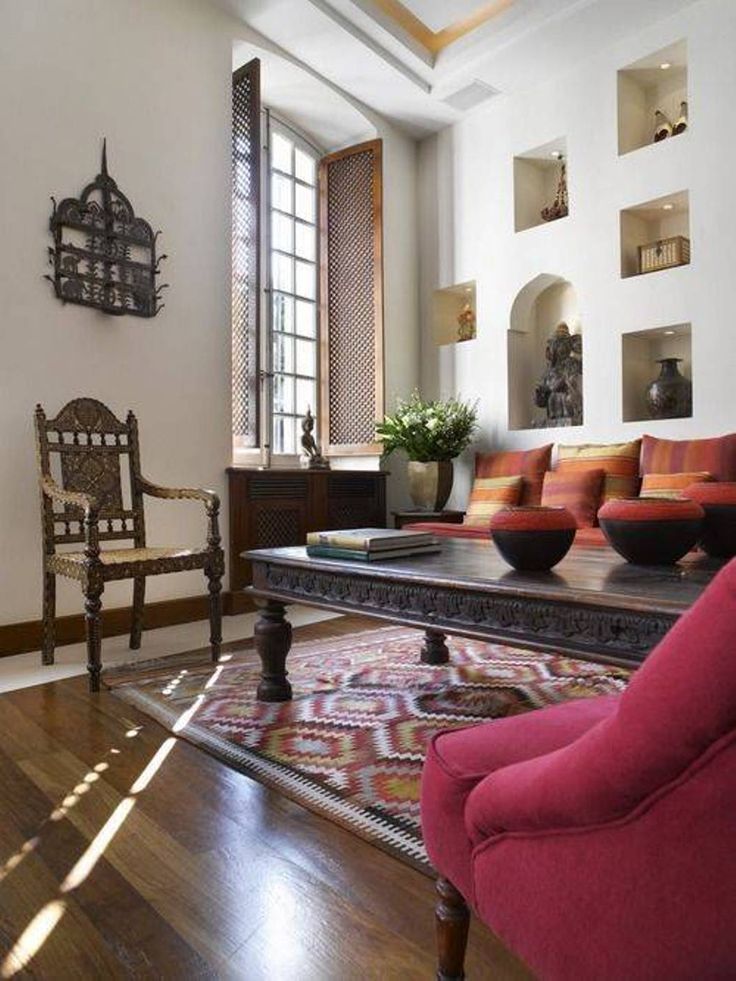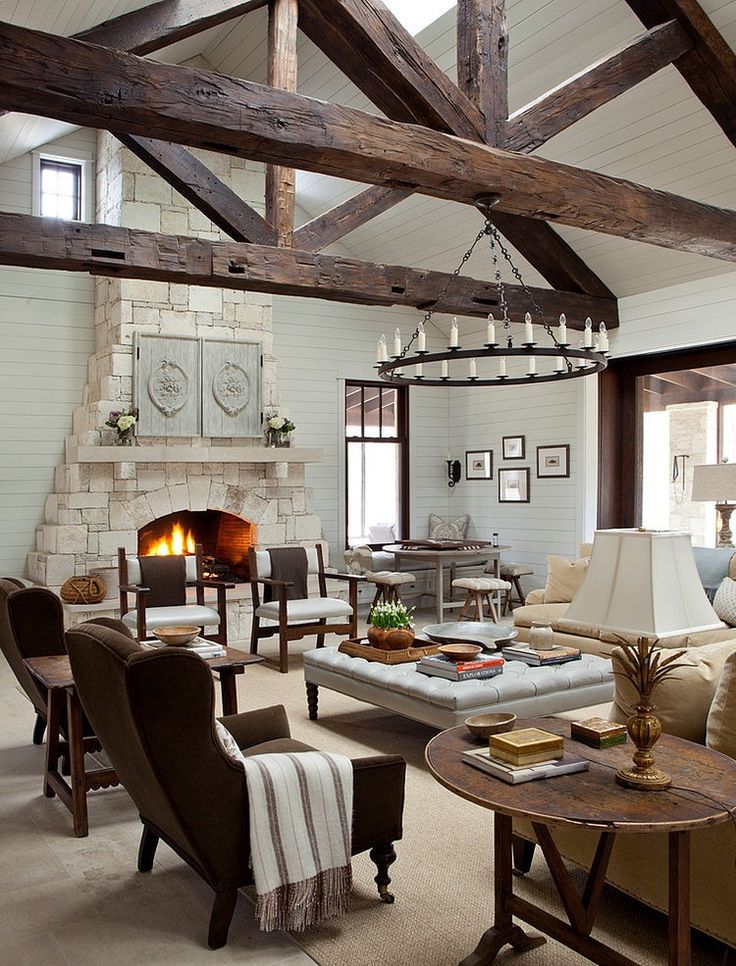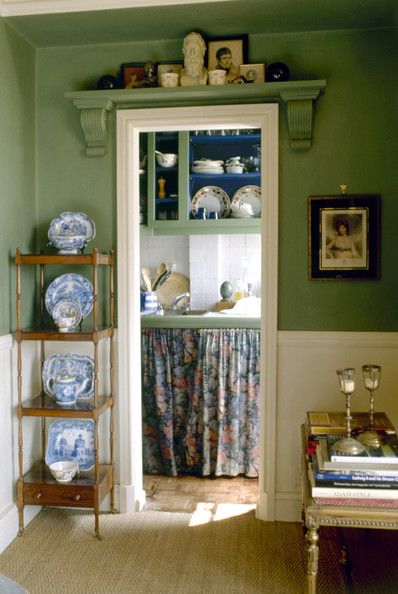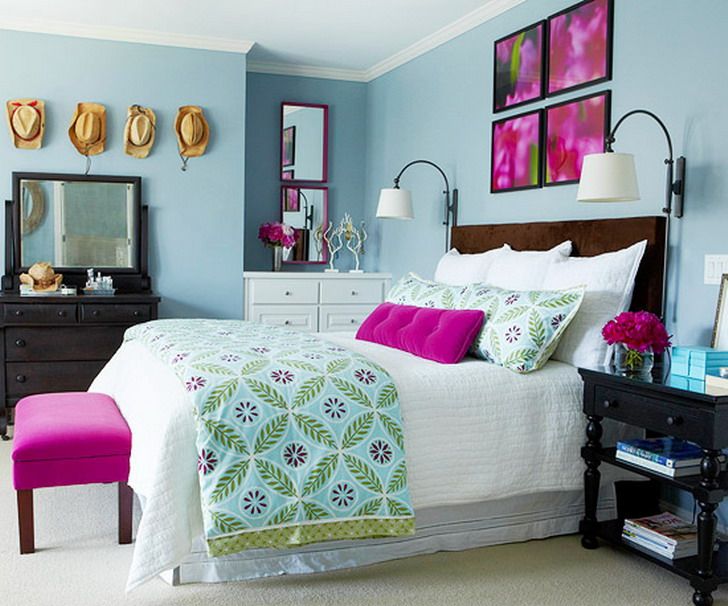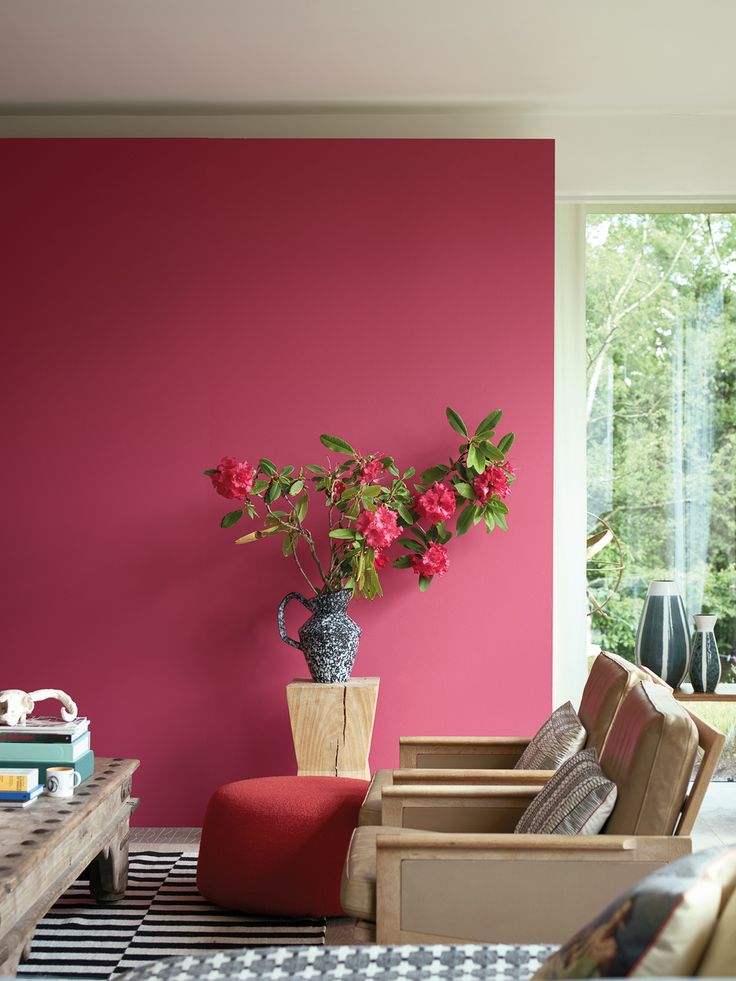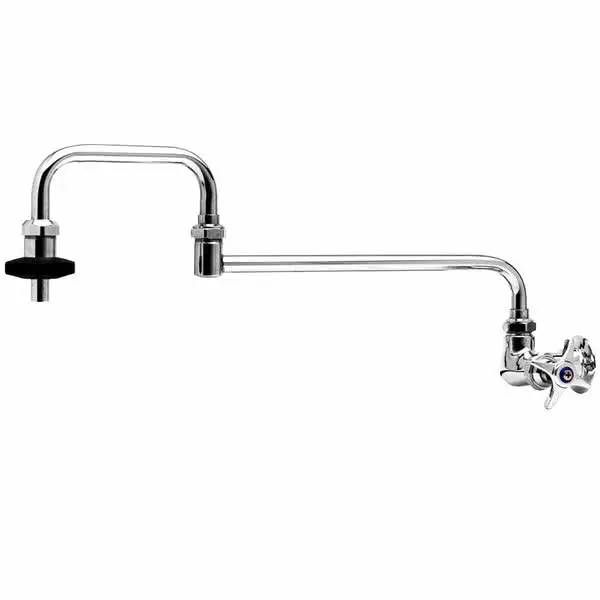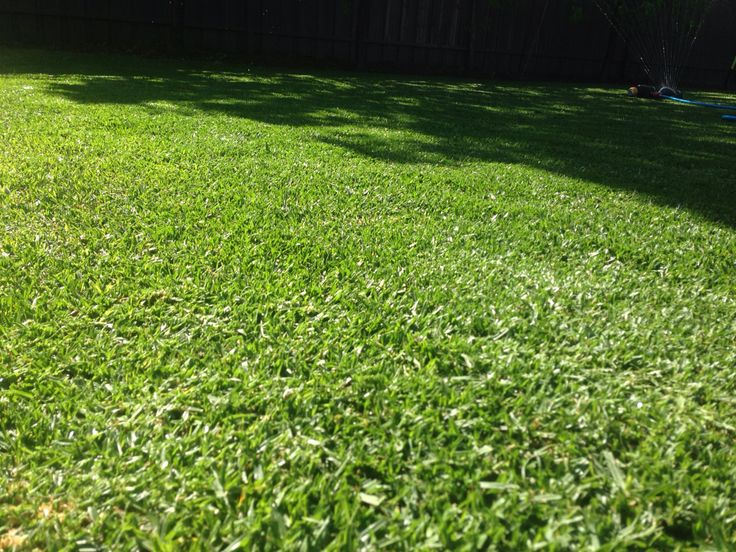Interior design for colonial style home
a guide to the look and how to get it |
(Image credit: Getty)
'Colonial style house' is an umbrella term that describes an iconic part of the US architectural landscape. This signature house style is one of the most popular property styles in the US due to its innate charm and period character.
Located across the US, Colonial style homes range from sought after historic homes to the more modern Colonial Revival properties.
We've rounded up everything you need to know about Colonial style houses inside and out below.
What is a colonial style house?
(Image credit: Alamy)
A Colonial style house is one of a variety of styles introduced by the early settlers to the US from Europe in the 17th, 18th and 19th centuries, built with materials that were available locally and in a style that was familiar to them. A swathe of Colonial Revival houses were built from the 19th century onwards, demonstrating that imitation is the sincerest form of flattery.
Where did Colonial style originate?
Colonial style homes were built by European settlers mainly from countries such as the UK, France, Holland and Spain. They can be found throughout the US but many are located in the coastal Eastern states.
'True Colonial style homes were built in the 1600s and 1700s on the East Coast during the time of colonization by the British government,' says senior architectural historian, Christina Dikas, an associate principal at Page & Turnbull , a historic preservation and architecture firm. 'The houses were typically square or rectangular in plan with a side gabled roof, stone or wood construction, thick brick chimneys, and small multi-lite windows.'
Types of Colonial style houses
There's plenty of variety with Colonial style houses. Expand your knowledge of the architecture trend with these key categories:
1. New England Colonial style
(Image credit: Brian Jannsen/ Alamy)
Think Little Women and you're instantly transported to the iconic New England Colonial style houses with their central front door and chimney, and rectangular windows.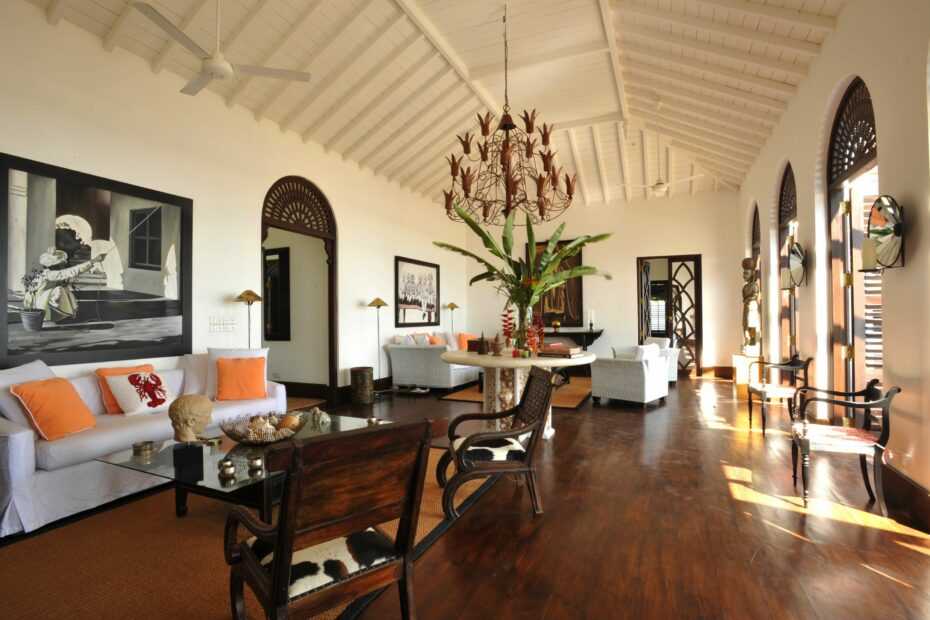 Author Louisa May Alcott's own home, Orchard House (above) in Massachusetts, built around 1650 and where she wrote and set Little Women, is a perfect example of the style.
Author Louisa May Alcott's own home, Orchard House (above) in Massachusetts, built around 1650 and where she wrote and set Little Women, is a perfect example of the style.
2. French Colonial style
(Image credit: Alamy)
French Colonial style houses, found in the South East, in particular Louisiana, exude elegance with their steeply pitched roofs and wraparound porches, verandas and balconies, as shown on the house above. Architectural features were designed to cope with the warm climate so verandas were built because they are perfect for alfresco living, while small dormers in the roofs and tall thin windows prevent too much heat entering the house. Raised basements also help protect the lower levels from flooding.
3. Dutch Colonial style
(Image credit: Paul Brady/ Alamy)
Dutch Colonial style houses can be found in New York, New Jersey, Connecticut, Pennsylvania and Delaware. Their most distinctive feature is the charming gambrel roof (such as on the house above).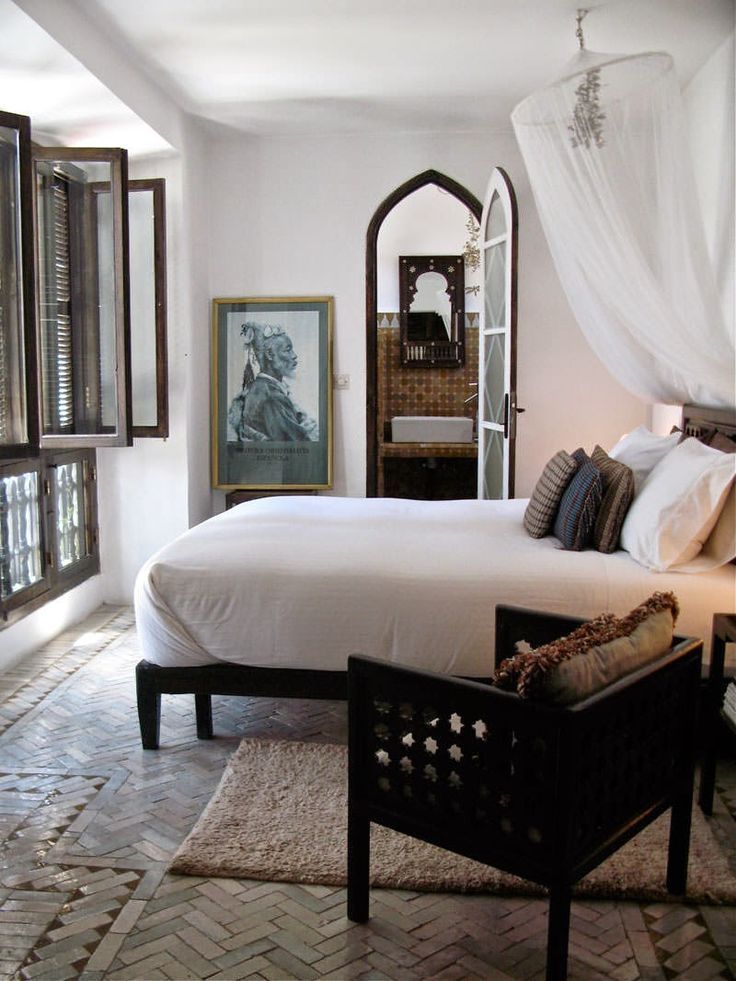 Other features include narrow dormer windows, shutters and central doors.
Other features include narrow dormer windows, shutters and central doors.
4. Spanish Colonial style
(Image credit: Frank Bach/ Alamy)
Spanish colonial style houses are known for their rustic appearance and can be found in Florida, California and in the Southwestern states such as Arizona and New Mexico. They were usually built with white stucco walls to deflect the heat and low pitched roofs made from red clay tiles. Other typical architectural features include few and small windows to help combat the heat, arches and a courtyard.
5. Colonial Revival homes
(Image credit: Matthew Kiernan/ Alamy)
According to Christina Dikas, US Colonial Revival or American Colonial Revival style homes became popular in the mid-19th and 20th centuries. 'Colonial Revival style became popular after the centennial celebrations of 1876, at which time Americans kindled an interest in colonial period architectural traditions,' she says.
'Taking their cues from houses of the American colonial period, the houses typically are characterized by an even symmetry built in wood, brick, or stone, with side gabled roofs, shuttered windows, brick chimney(s), and centered front door.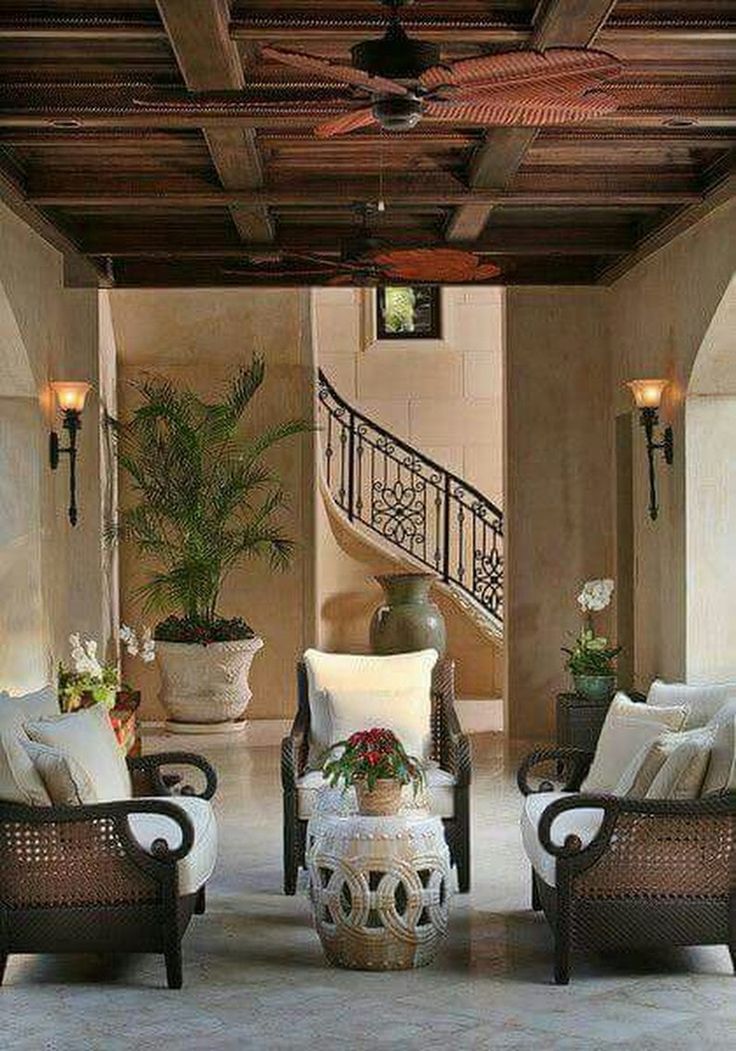 Some include an open front porch, columns, and dormer windows. Inside, the two- or three-level houses commonly feature crown molding, a dedicated entryway with centered hallway and a grand stairway. Their spacious scale allows for ample kitchen and living areas, multiple bedrooms, and den/office rooms, along with a full basement.'
Some include an open front porch, columns, and dormer windows. Inside, the two- or three-level houses commonly feature crown molding, a dedicated entryway with centered hallway and a grand stairway. Their spacious scale allows for ample kitchen and living areas, multiple bedrooms, and den/office rooms, along with a full basement.'
Christina continues: 'While the typical Colonial Revival style house, as described above, is based on British colonial architecture, other variations around the country reflect different cultural influences, including Spanish and Dutch colonial styles (such as the house above).'
Why are Colonial style homes so popular?
A combination of factors makes Colonial style houses so sought after. Apart from the fact you're buying into a piece of history, Colonial style houses are visually appealing and their classic good looks are guaranteed to stand the test of time.
Practicality was a key consideration when they were built so they have functional features such as small windows to keep the heat out, and they're durable because they were built to last.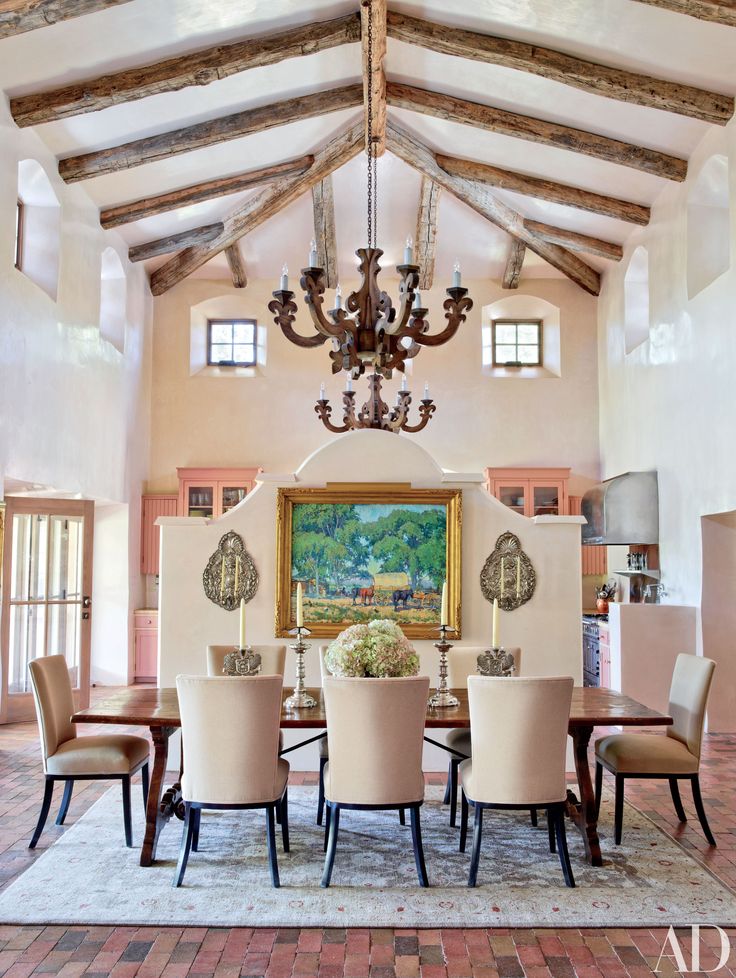 Another plus is that they are built from natural materials such as wood and stone, as opposed to manufactured building materials.
Another plus is that they are built from natural materials such as wood and stone, as opposed to manufactured building materials.
'The architecture and design of Colonial homes center on family life, with spacious rooms designed for comfort and warm finishes, such as hardwood floors and stone fireplaces,' says Christina. 'They are well-proportioned at the exterior, making them aesthetically pleasing. They also conjure up a romanticized vision of an earlier American period and symbolize traditional values.'
What to look for in a Colonial style home
'Symmetrical architecture is a hallmark of US colonial homes,' says Christina. 'Some of the houses have given way to modern families’ overriding preference for open floorplans and a finished basement. Steep rooflines, centered doors and windows, natural finishes, and spacious rooms are common.'
Interiors have always been Vivienne's passion – from bold and bright to Scandi white. After studying at Leeds University, she worked at the Financial Times, before moving to Radio Times.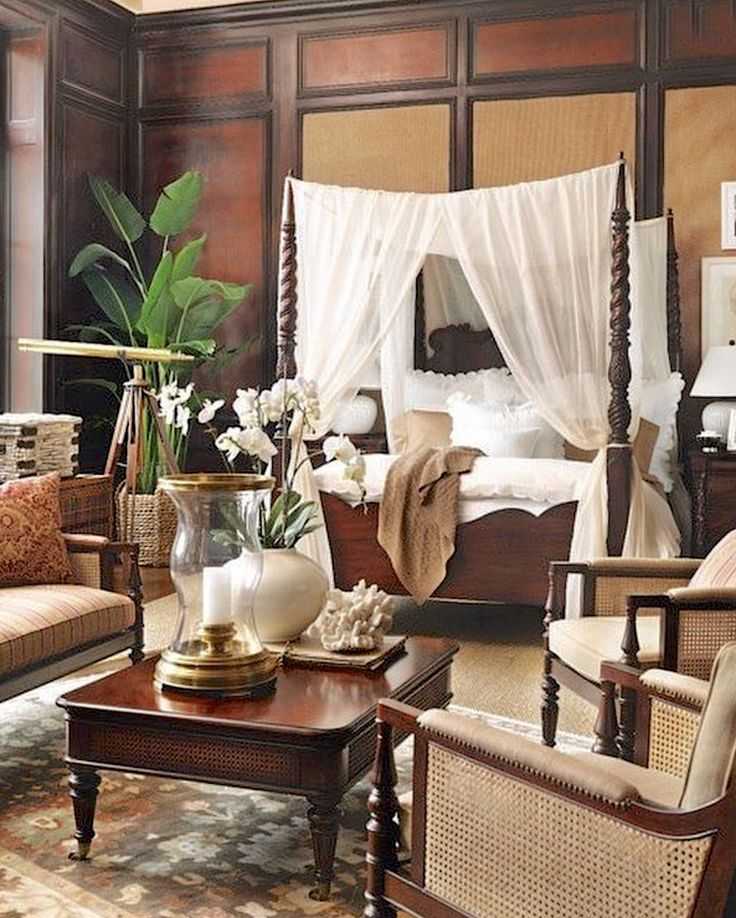 She did an interior design course and then worked for Homes & Gardens, Country Living and House Beautiful. Vivienne’s always enjoyed reader homes and loves to spot a house she knows is perfect for a magazine (she has even knocked on the doors of houses with curb appeal!), so she became a houses editor, commissioning reader homes, writing features and styling and art directing photo shoots. She worked on Country Homes & Interiors for 15 years, before returning to Homes & Gardens as houses editor four years ago.
She did an interior design course and then worked for Homes & Gardens, Country Living and House Beautiful. Vivienne’s always enjoyed reader homes and loves to spot a house she knows is perfect for a magazine (she has even knocked on the doors of houses with curb appeal!), so she became a houses editor, commissioning reader homes, writing features and styling and art directing photo shoots. She worked on Country Homes & Interiors for 15 years, before returning to Homes & Gardens as houses editor four years ago.
Colonial Homes and Everything You Need To Know About Them
By Stefan Gheorghe | Published on Reviewed by Vera Dordick
Buy Now
Colonial homes are a fixture in American residential architecture in New England and along the East Coast.
If you grew up in the U.S., you probably went to some kind of museum in a historical home. Scattered across the country, they all smell like dust and memories. Maybe you noticed that the house looked just like the previous old home you toured. Most likely, it was an example of Colonial Revival architecture.
Scattered across the country, they all smell like dust and memories. Maybe you noticed that the house looked just like the previous old home you toured. Most likely, it was an example of Colonial Revival architecture.
While touring a traditional old Colonial home is a fun experience, living in one presents challenges. You have an urge to protect its history while making the space livable for your family. Learning about the history of the home can help you decide what is important and what you can change.
Here is everything you need to know about Colonial houses.
View in gallery
View in gallery
View in gallery
Origins of Colonial Houses
Colonial architecture came with the landscape of the early American colonies. The styles varied by what power controlled the region. Classic Colonial homes were modeled after the ever-popular Georgian houses, rooted in British colonial architecture. These were constructed with a strict nine window grid and front door on the facade.
These were constructed with a strict nine window grid and front door on the facade.
Mostly wood, you might also find double chimneys and in grander houses, a wing or two off the sides. Later homes boasted brick across the front with siding around the back. No matter the date, Colonial houses are still quite symmetrical because they are easier to build.
The same traditional symmetry can be found in different types of styles, such as French Colonial or Spanish Colonial.
Colonial Exteriors
View in gallery
A true historic Colonial house will probably be quite plain. You’ll find the traditional window grid across the front and wood siding around the exterior. But thanks to Georgian styles and British colonial architecture, Colonial homes will often have a pediment that keeps them from looking too straightlaced.
View in gallery
While clapboard siding was the most common among historic Colonial architecture, you could find brick facades as well. And, you might prefer that for your American Colonial style house. With a straightforward design, the brick pattern provides interest that British Colonial architecture lacks.
And, you might prefer that for your American Colonial style house. With a straightforward design, the brick pattern provides interest that British Colonial architecture lacks.
View in gallery
Every so often, you might come across a traditional Colonial home with a stone exterior. Know that you’ve hit the jackpot. Houses built as stone Colonials are hard to find. If you can snap it up, make sure you do everything possible to preserve its historical integrity for future generations.
View in gallery
A historic American Colonial style house would rely on fireplaces for heat in the harsh winters and use them for symmetry on the exterior. Embrace those brick columns as you design your exterior.
View in gallery
A modern Colonial style house is rarely so authentic due to our contemporary needs. It’s common to find a wing off the side of the house that serves as a garage, but with similar window styles, it can blend with the rest of the house.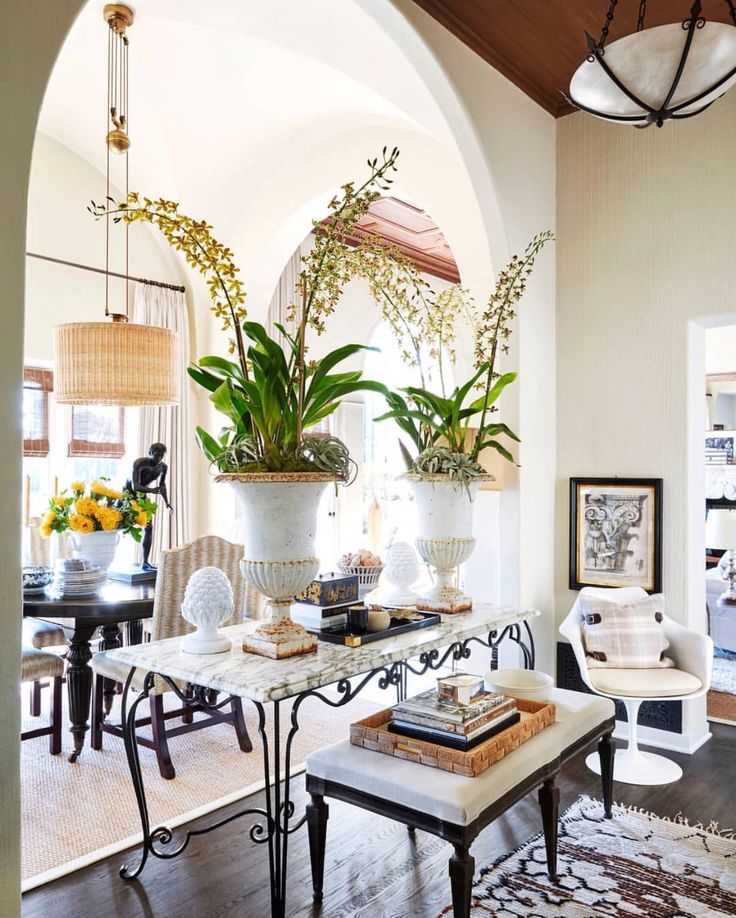
View in gallery
Does your American Colonial-style home have one wing off one side? Add another off the opposite side for the cherished symmetry of Colonial architecture. You’ll also make your home’s facade look more grand.
View in gallery
You might not realize how easy it would be to turn Colonial architecture into a mock Georgian. Add flourishes at the corners, around the roof and by the front door. This easily a facade of grandeur and elegance for colonial style houses.
View in gallery
Don’t think that the exterior of modern colonial homes is limited to plain colors. Painting your siding with an eye-catching shade like dusty gray, blue or even black can bring your home up to date with the rest of the neighborhood.
View in gallery
Even the littlest pop of color can bring a total home refresh. If you don’t have the funds to paint your entire house, paint your front door.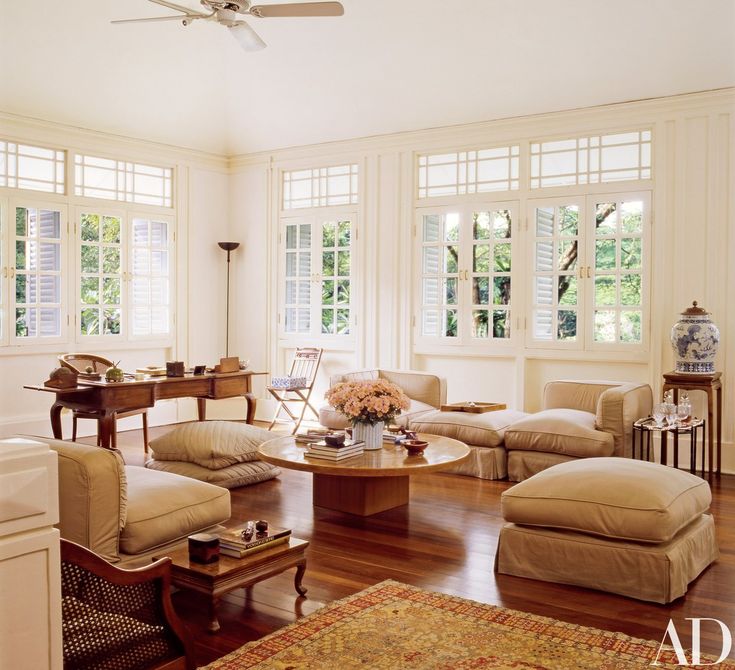 Unexpected colors like red, turquoise or purple will give your American Colonial style home’s exterior new life.
Unexpected colors like red, turquoise or purple will give your American Colonial style home’s exterior new life.
View in gallery
Colonial Style House Interiors
Expanded entryway
View in gallery
If you thought that the Georgian similarities stopped at that Colonial door, think again. Most Colonial architecture opens to an entryway-like hall that often went the length of the home with rooms off of it. This creates separate rooms and not an open floor plan.
Low ceilings
View in gallery
Low ceilings were just a part of colonial architecture so don’t be surprised if your Colonial style home has them. Rather than expand, work with the height if it doesn’t make it uncomfortable for you or your family. It will save your budget and add to the home’s history.
Architectural style
View in gallery
Hello, details.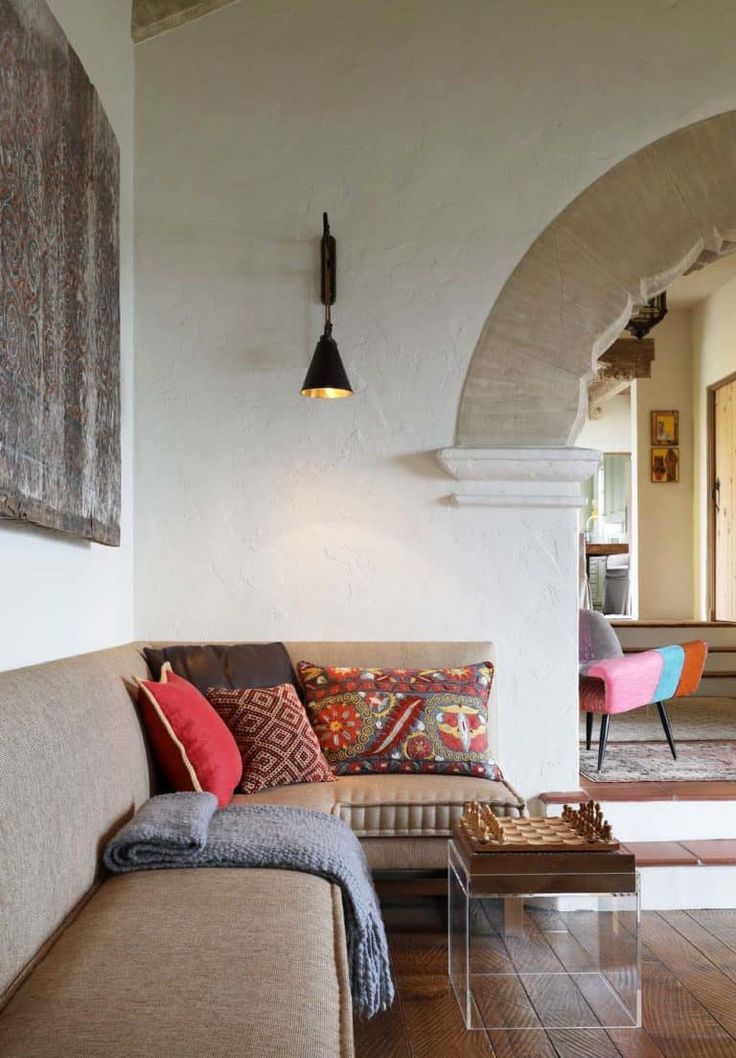 Just like Georgian homes, Colonial style houses can show off just as many architectural pretties. Look for detailed ceilings, decorative molding and ornate trim around the house. While you might have to paint and touch up, it will save you from installing entirely new details .{found on architecturaldigest}.
Just like Georgian homes, Colonial style houses can show off just as many architectural pretties. Look for detailed ceilings, decorative molding and ornate trim around the house. While you might have to paint and touch up, it will save you from installing entirely new details .{found on architecturaldigest}.
Exposed beams
View in gallery
If you thought that a Victorian home had some cool old beams, you should see the attic bedrooms in Colonial houses. As long as their age doesn’t impact the structural soundness of your home, they can have a powerful effect on your decor, especially in bedrooms.
Fireplaces
View in gallerylamp out to remove curio cabinetRemember what we said about exterior chimneys? That means you probably have at least one fireplace to work with. Thank goodness they’re usually an eye-catcher. Decorate the mantel to your heart’s desire and if the fireplace is non-working, you get to be creative on the inside too.
Wallpaper
View in gallery
Wallpaper was definitely a thing back in colonial days. While you probably won’t find it in historic Colonial houses, you can definitely install it yourself. Choose a close pattern in bright colors to make your space feel like you’ve stepped back in time.{found on architecturaldigest}.
Neutral palette
View in gallery
When you want to find the perfect in-between for a historic home and the decor that it holds, neutral colors will never let you down. Fill your home with creams, browns and beiges to create a feeling of authenticity even though all the decor is contemporary.
Use antiques
View in gallery
If you have a little cash to spend, frequent antique shops. You can fill your home with pieces that look like they belong in a past life. Bonus points if the piece comes with a story.
Go modern instead
View in gallery
Don’t worry if your house style choices veer to the modern. Try to keep the details of the Colonial architectural style but decorate however you like! Modern art and furniture look even better when unexpected.
Create a sleek interior
View in gallery
It might seem contrary but sleek and clean can be a good combination against the historic values of a Colonial home. If you’re revamping a space like a kitchen or a bathroom, consider going modern with your big pieces for a seriously custom home.
You can never have too much inspiration when it comes to colonial homes, so let’s look at a few more. There are plenty of beautiful examples of this style. Each is beautiful and unique in its own way so it’s always worth checking them out.
A colonial house on a lake in Minnesota
View in gallery
This home is located close to Turtle Lake in Minnesota and has a lovely view and beautiful landscape.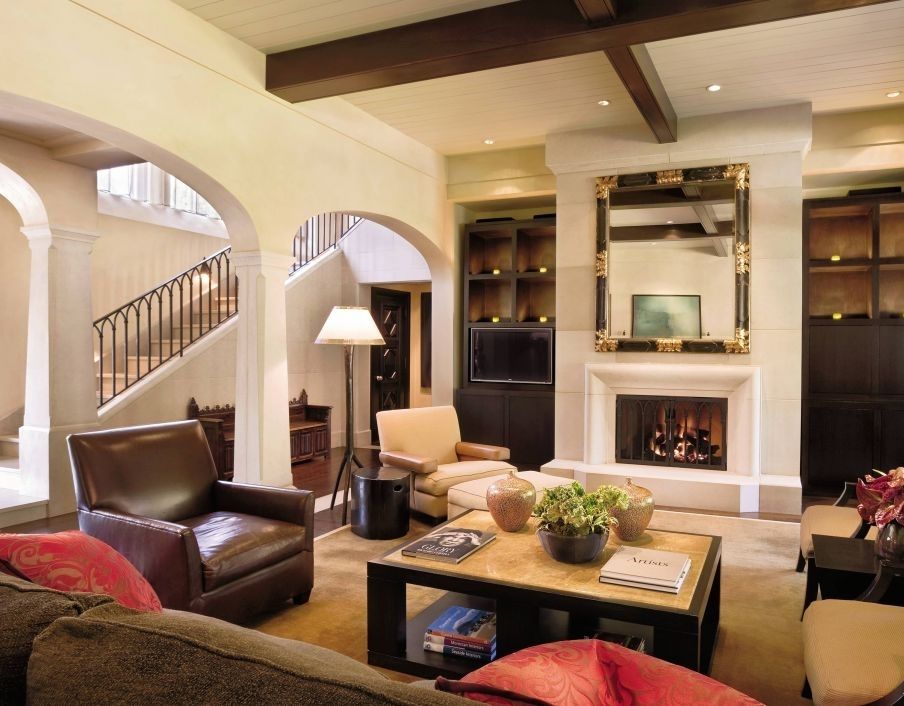 Murphy & Co. Design created this American colonial style house with a big L-shaped floor plan. The main entrance has a little roofed porch area with more of these outdoor nooks all around the house.
Murphy & Co. Design created this American colonial style house with a big L-shaped floor plan. The main entrance has a little roofed porch area with more of these outdoor nooks all around the house.
The color palette used for the exterior is light and warm. The house features weathered shingles on the roof which match the aesthetic of the exterior walls. The windows have blue wooden shutters which add a little bit of color to the facades. The front door is also blue and the interior has a very similar chromatic palette as well. The staircase which leads upstairs features blue carpet and there’s more blue accents in each room in various different forms like the backsplash in the kitchen or the little side table in the sitting room.
A colonial farmhouse with a modern interior
View in gallery
The inspiration behind the design of this American Colonial style house came from the farmsteads found in Pennsylvania back in the 18th and 19th centuries. Studio Murphy & Co. Design applied a similar aesthetic to this colonial farmhouse in Minneapolis.
Studio Murphy & Co. Design applied a similar aesthetic to this colonial farmhouse in Minneapolis.
View in gallery
They also made sure it is suitable for a modern lifestyle. The exterior has American colonial architecture. It is adorned with white cedar cladding and wooden shingles, windows with shutters and prominent roof lines.
View in gallery
View in gallery
The interior, on the other hand, has a modern flair with open-concept layouts. It does of course also have a charming, warm and inviting look and feel. However, it’s also meant to look refined and bright and airy with plenty of windows. It’s a nice mix of architectural styles, giving it lots of character.
The designers used a selection of traditional and modern materials, finishes and furnishings to create a unique environment, including the bedrooms.
A Dutch colonial style home in New York
View in gallery
This home is located in New York, in an area populated with lots of old and classic structures.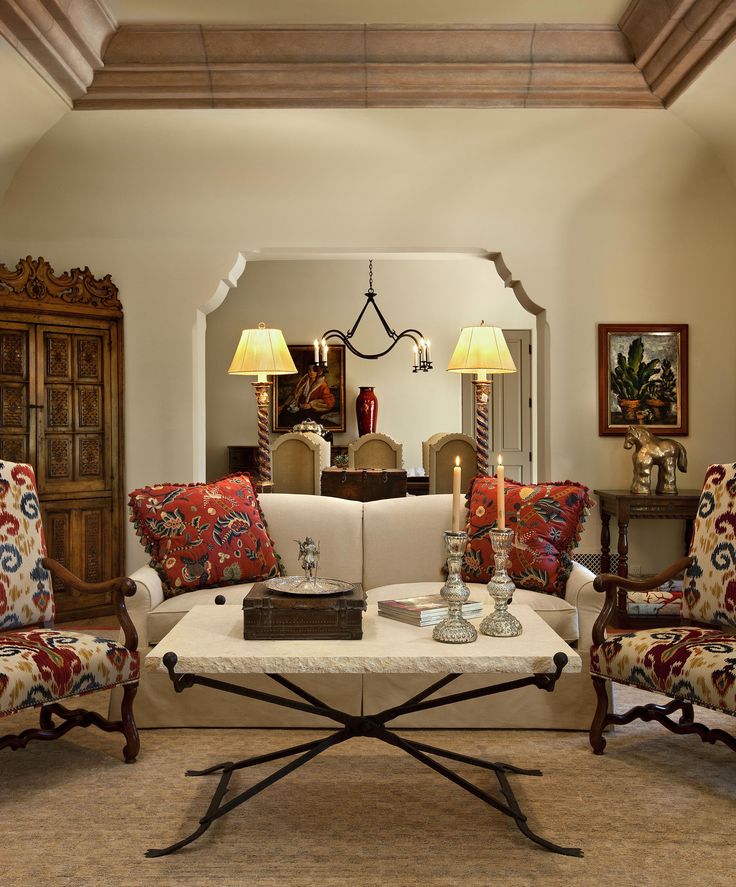 As such, the owners wanted it to blend in and to look as if it has been there for generations. They worked closely with Mackin Architects.
As such, the owners wanted it to blend in and to look as if it has been there for generations. They worked closely with Mackin Architects.
They settled on a Dutch colonial-style home design and wanted to keep the scale of the Colonial house similar to those of neighboring homes. Thus, the architects integrated the second story of the building into the roofline and constructed dormer windows for the bedrooms.
This design strategy allowed the Colonial house to be quite big on the inside while maintaining a scaled-down aesthetic that matches the overall community. The interior rooms have plentiful windows and extend onto large wraparound porches. Some of these features come from French colonial homes.
The interior is inviting, light and airy and has a classical vibe while also being optimized for a modern lifestyle.
Frequently Asked Questions (FAQ)FAQ
What defines colonial style?
Typically found on the US East Coast and New England, rooted in a British colonial tradition, colonial style homes have a distinct look.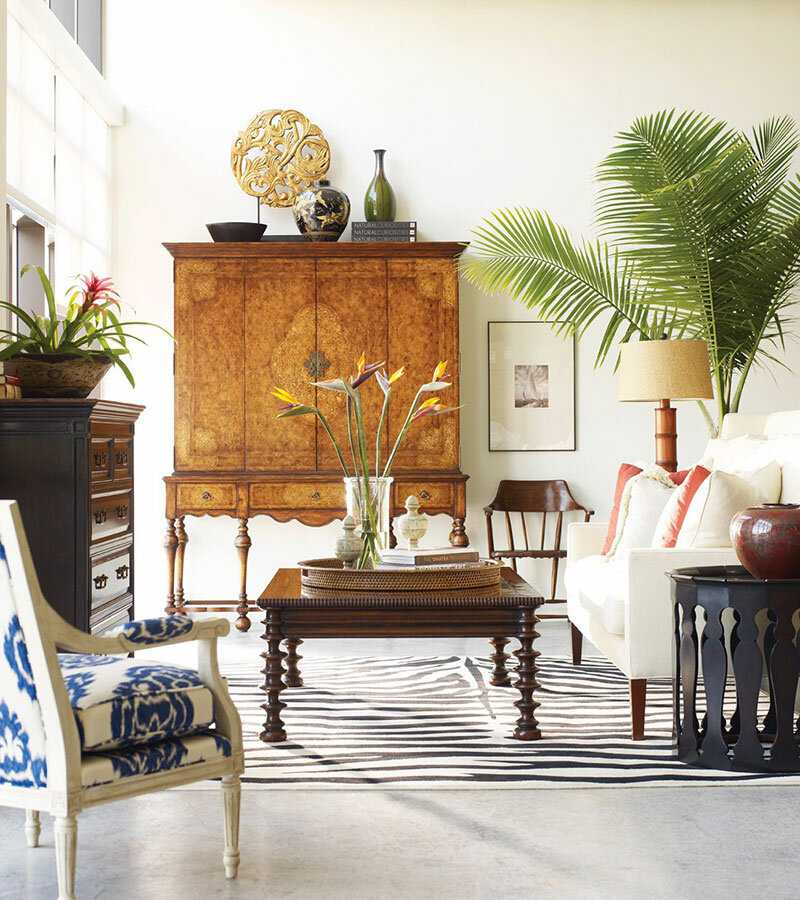 They have a simple rectangular shape and tend to be two to three stories tall. Facades are usually wood and sometimes stone. A colonial house has one, perhaps two fireplaces.
They have a simple rectangular shape and tend to be two to three stories tall. Facades are usually wood and sometimes stone. A colonial house has one, perhaps two fireplaces.
The specific country that colonized an area drives the architectural styles. These include Spanish colonial and French colonial style houses.
What makes a house colonial style?
Colonial styles have two or three stories, brick or wood facades and at least one fireplace if not two. The floor plan puts the kitchen and living spaces as separate rooms on the first floor and the bedrooms upstairs.
What is colonial style decor?
American Colonial style homes typically have decor that is neutral in color. Interiors have large entrance halls, wood floors, simple color schemes, wainscoting and millwork that is not too over the top.
What style is Colonial Revival?
Colonial Revival is basically a mish-mash of styles creating a quintessentially American colonial architecture. Roofs can be gabled, hipped, or gambrel.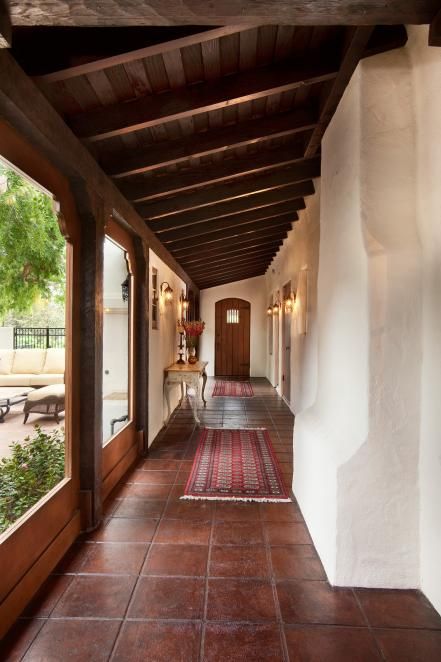 A Colonial house can also include dormer windows. It’s a diverse style that can easily be adapted to contemporary lifestyle needs. Cape Cod style in New England is an example.
A Colonial house can also include dormer windows. It’s a diverse style that can easily be adapted to contemporary lifestyle needs. Cape Cod style in New England is an example.
Conclusion
Modern colonial homes improve on the best elements of an architectural style that grew out of British colonial rule. Many colonial houses are modest, but they can also be quite grand. As popular as they are if you want a one, you can surely find a colonial house to fit your budget and your family.
Colonial style in the interior: features and photos
The shelves are full of exotic souvenirs, the cabinets are filled with guidebooks to hot countries, the free space in the passport is running out, and the soul needs adventure again... about the next safari in the appropriate environment is much more pleasant.
History
The appearance of the colonial style is directly related to the era of great geographical discoveries.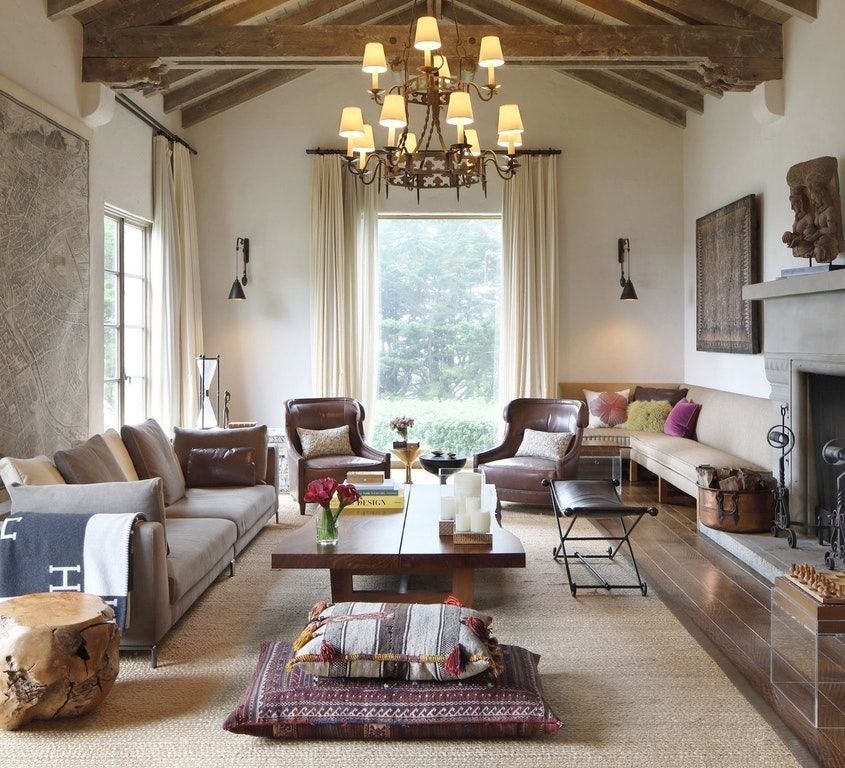 At this time, the world was ruled by powerful maritime powers: England, Spain and Portugal. In an effort to expand their possessions, they founded colonies in Africa, Australia, Asia, and India. In general, to wherever their imperious hand reached out.
At this time, the world was ruled by powerful maritime powers: England, Spain and Portugal. In an effort to expand their possessions, they founded colonies in Africa, Australia, Asia, and India. In general, to wherever their imperious hand reached out.
Naturally, the newly minted settlers needed somewhere to live, and they built simple practical houses according to European traditions. However, the unusually hot climate and natural human curiosity did their job - oriental flavor gradually began to penetrate into strict classical interiors. This is how the bright and amazing colonial style was born, which remains in demand even after several centuries.
Features of the colonial style
Considering the scale of the development and settlement of new territories of that time, it is not surprising that the colonial style of the interior has several directions. These include English, American, French, Spanish, African and Indian. Today we will consider only the general signs.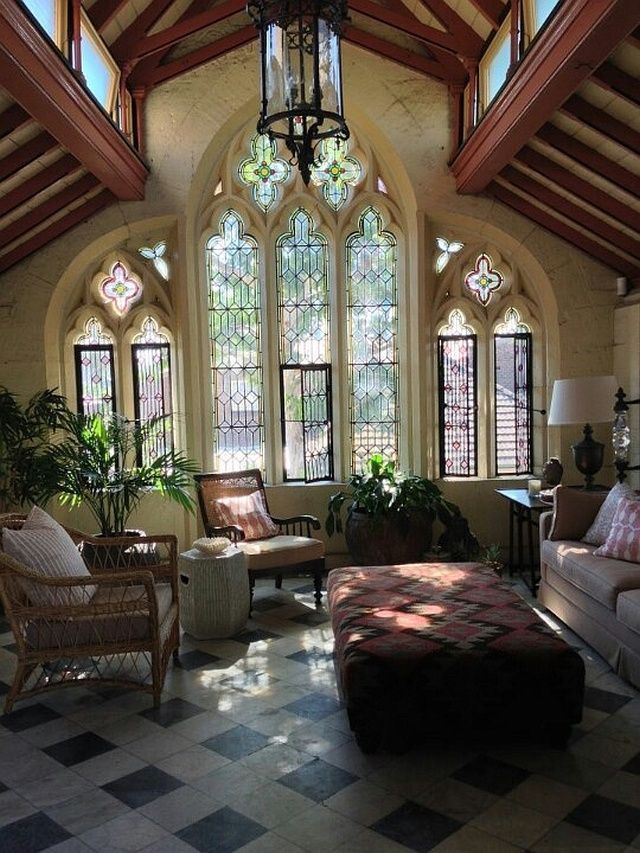
Colonial highlights:
-
harmonious combination of European classics and oriental flavor
-
use of natural materials
-
natural colors + bright accents
-
exotic decor items
Materials
When designing an interior in a colonial style, special attention is paid to materials - they must be natural. In the first place are stone and wood. They are confidently followed by copper, bronze, brick and clay. Expensive wood species, such as wenge or meranti, speak for themselves. However, there are also less expensive options available. Bamboo, rattan and rubber products will help to create an atmosphere of light exoticism and proximity to wild nature.
Floor, wall and ceiling finishes
Walls and ceilings are most often decorated in light neutral colors: sand, cream, milky, or left white.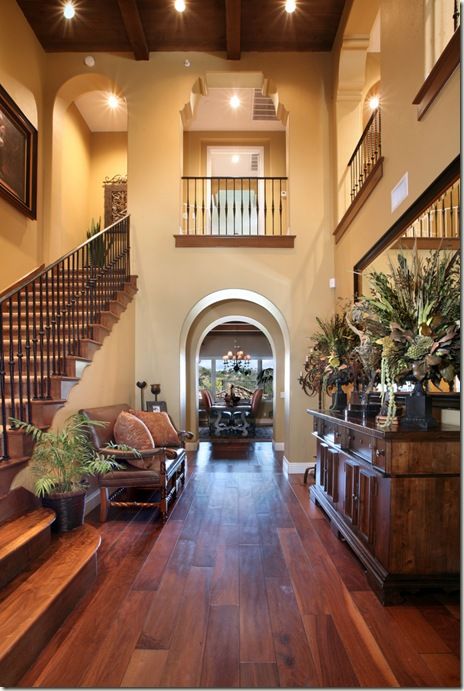 Wallpapers with patterns with animal and plant motifs look good.
Wallpapers with patterns with animal and plant motifs look good.
The ceiling with wooden beams looks spectacular, but this option is appropriate only in country houses and apartments with ceilings above three meters. If you want something unusual, it is decorated with interior fabrics, canvas or leather. Since the main flooring is parquet, you can add a bit of variety with the help of bright multi-colored carpets or textured mats. Other materials in flooring are rarely used.
Color palette
Walls and ceilings usually act as a background, so they are painted in light pastel colors. To create an expressive contrast, furniture of a rich dark color is selected. Ocher, gold, olive and terracotta shades look interesting, but bright accents are also acceptable.
Furniture
There are no strict principles in choosing furniture. It is good - we are for diversity! The main selection criterion is natural materials.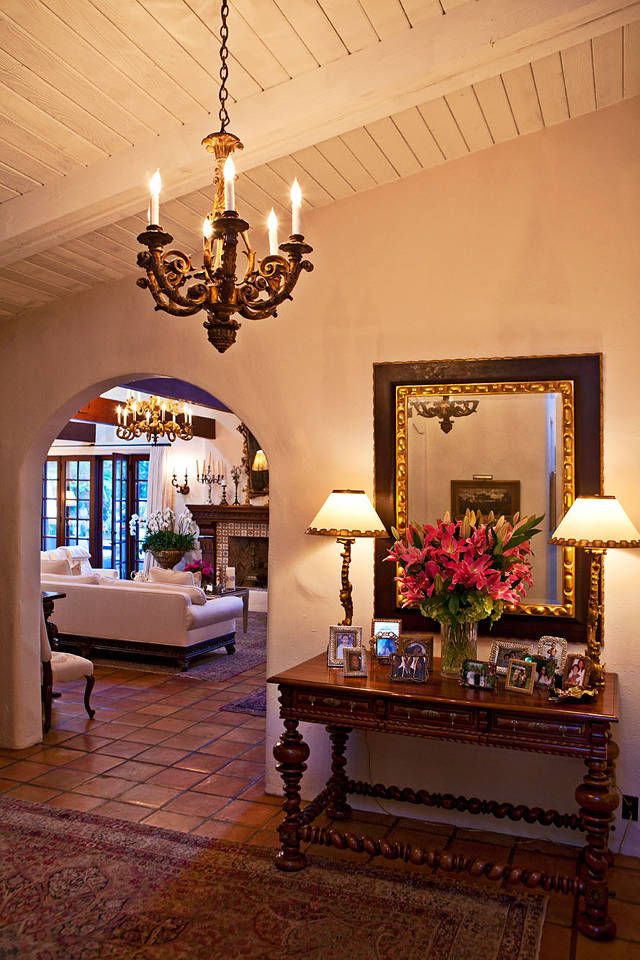 Durability and practicality, too, has not been canceled.
Durability and practicality, too, has not been canceled.
Living room in colonial style
Living room, according to the designers, is the most organic place for colonial style. Everything here should be conducive to a calm, relaxed conversation and relaxation. Among the classic furniture, you can arrange several wicker chairs with colorful pillows, and lay a mat or carpet imitating an animal skin on the floor.
Colonial style bedroom
The main decoration of the bedroom is a massive canopy bed. Just a few centuries ago, it would protect your sleep from annoying insects, but today it is just a colorful element of decor. The mood will be enhanced by an antique-styled chest or chest of drawers.
Colonial style kitchen
A carved set with an island will look harmonious in a colonial style kitchen. The table and chairs, on the contrary, choose simple shapes so as not to overload the interior.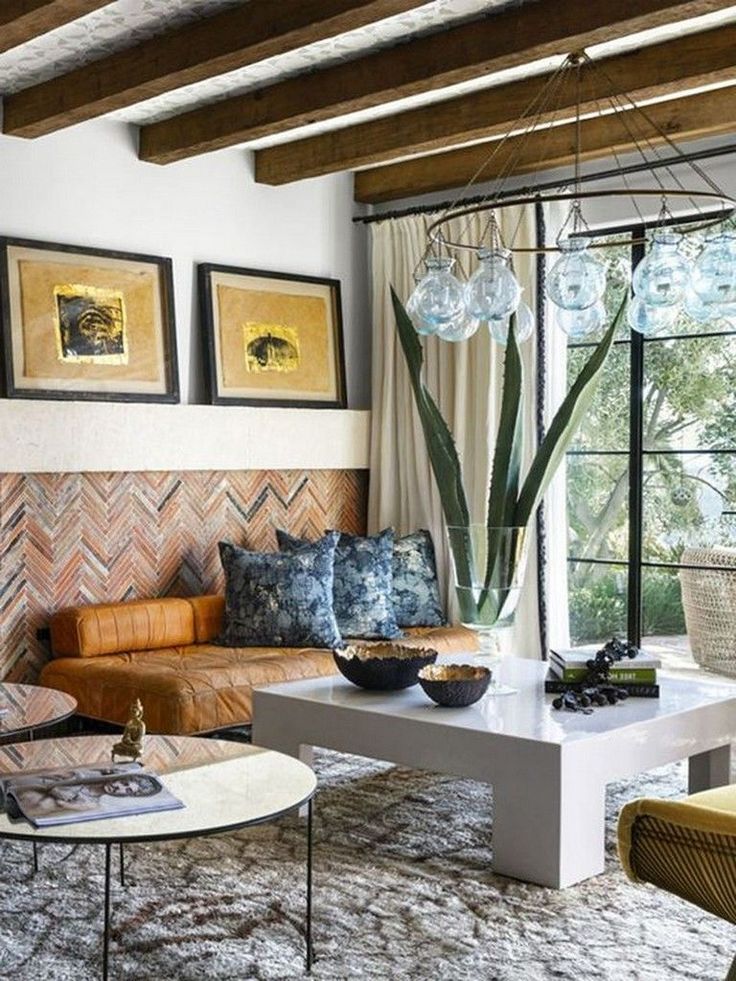 A large stone stove or its imitation will help create a cozy homely atmosphere.
A large stone stove or its imitation will help create a cozy homely atmosphere.
Decor
We left decor for dessert, because it is what makes the atmosphere in the house unique. Wicker baskets, colorful carpets, African masks, figurines of animals and people, globes, maps, books - now you know exactly what souvenirs to bring back from your vacation. It is a good idea to settle in the apartment of the natives of warm countries: a miniature palm tree in a tub, a branchy fern or a whimsical tropical flower. They will not only remind you of the approaching spring, but also clean the air of carbon dioxide.
Colonial interior style is European comfort and oriental flavor in one bottle. It is suitable not only for avid travelers, but also for people who still dream of adventure. Feel the hot air of the savannah and the freshness of the waterfall without leaving your home. Everything is in your hands - go for it!
Colonial style in the interior - Ottoman
Do you want to somehow update the interior of your house, but popular trends in design do not suit you? Pay attention to the colonial style.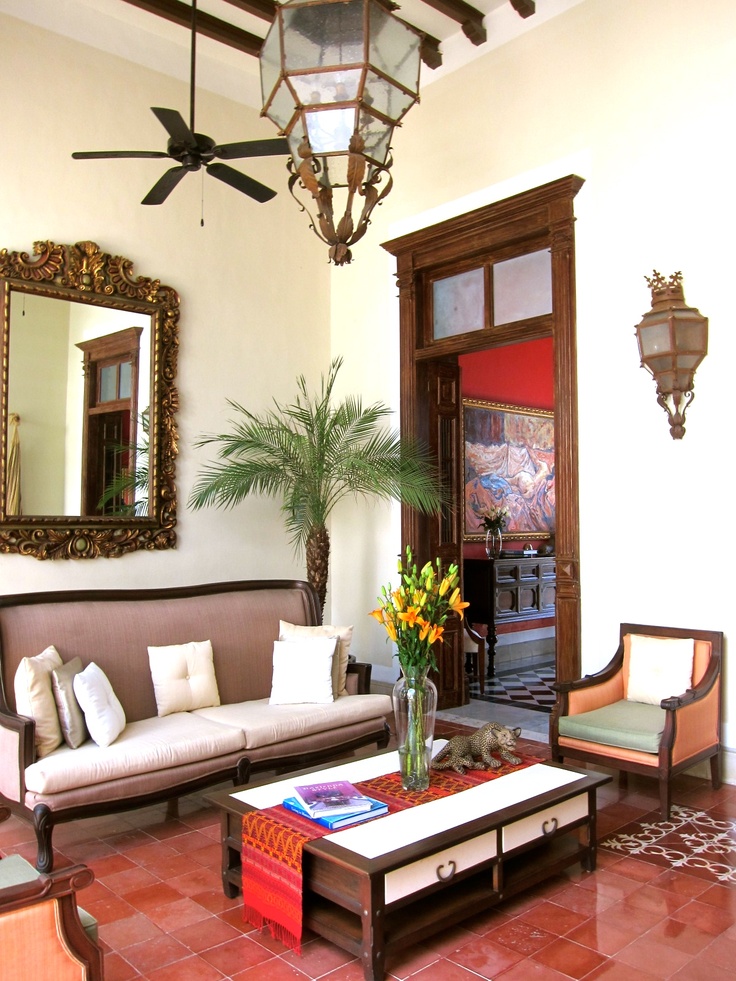 With it, you can emphasize your wealth, enhance the feeling of comfort and coziness.
With it, you can emphasize your wealth, enhance the feeling of comfort and coziness.
The name of the style comes from the time of the mighty British Empire, when it included more than a quarter of the lands of Asia, Africa and the New World. Of course, the British imposed their language and even culture - certain English features appeared in the interior of the houses.
Contents:
- Features
- Flowers
- Architecture
- Walls and ceilings
- Curtains and fabrics in colonial style
- 0020
- Décor
- Patterns
Characteristics
Despite the fact that several centuries have passed, the idea of colonial style remains the same - a reasonable combination of rich luxury, comfort and exoticism. Pay attention! This design of the apartment is suitable for those whose wealth is above average. High-quality natural materials, decoration and decor cost a lot.
Flowers
The most striking hallmark of the colonial style is exotic plants. Around the lush and stormy vegetation, everything is green and bright. Naturally, the inhabitants of the eastern territories decorated their homes in the most accessible way - with palm trees and ferns.
Around the lush and stormy vegetation, everything is green and bright. Naturally, the inhabitants of the eastern territories decorated their homes in the most accessible way - with palm trees and ferns.
Please note! This is not about one almost withered palm tree in the corner, which is sincerely sorry for everyone who enters. In a colonial style, greenery standing in several tubs is a delight to the eye of anyone who enters the room.
If you do not like or do not know how to take care of plants, do not torture yourself and flowers - skip this paragraph. Do not forget that the main goal is to achieve maximum comfort and coziness.
Special architecture
Most often, the owners of two-story houses choose the colonial style. It is in this case that the designer has a place to roam and show imagination.
Since the house is being equipped according to the principles of past years, no plastic and stretch ceilings.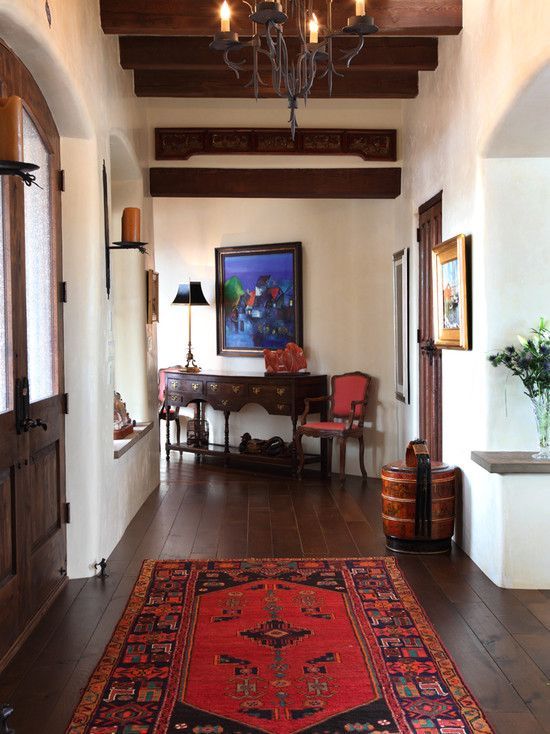 Artificial materials are too conspicuous. High-quality wooden windows will warm you in winter as well as plastic ones, and dark wood doors will give you an unforgettable feeling of comfort.
Artificial materials are too conspicuous. High-quality wooden windows will warm you in winter as well as plastic ones, and dark wood doors will give you an unforgettable feeling of comfort.
Tip! It would be nice to make several exits to the garden: from the kitchen, bedroom or hall. A large window to the floor and the phrase "go out the window" will change its tragic meaning.
Suitable facing materials are natural stone and wood. Just imagine: the facade of the house is lined with stone masonry, massive wooden window and doorways, natural wood flooring, wicker furniture and you. The only thing missing is a fireplace and a fluffy rug underfoot. In such a place, everyone will feel the comfort and warmth of their home.
Please note! The colonial style uses dark woods: red, wenge and bamboo.
Walls and ceilings
The design uses natural materials: stone, wood, copper, clay and brick.
If you don't want to bother with wallpapering, you can paint the walls in a light shade.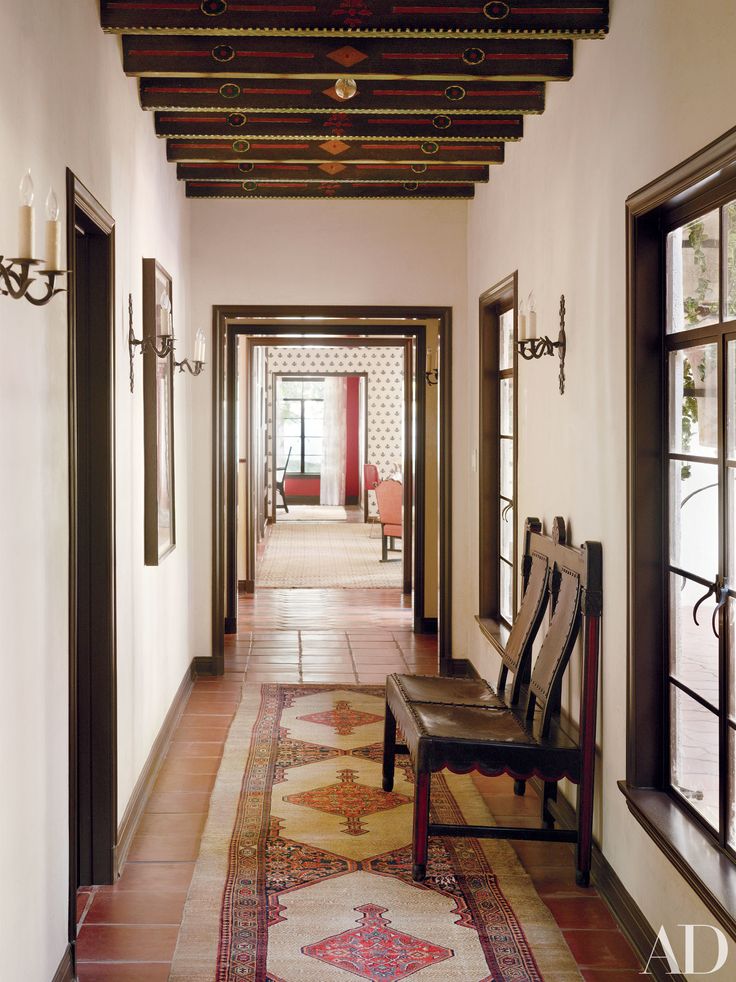 Beige or cream is best - they will give a feeling of air and visually enlarge the room.
Beige or cream is best - they will give a feeling of air and visually enlarge the room.
Do you like wallpapers more? Choose them. Solid colors or products with a small bamboo pattern will look great.
Tip! Want something more vibrant? Then look for wallpaper with an exotic pattern. A prerequisite is natural colors. Otherwise, the walls will be knocked out of the general plan.
Ceilings can be left plain and bright, or decorated with fabric or leather. This will give the interior more pretentiousness and grace.
The floor should be darker than the walls and ceiling, but also preferably a solid color. This surface design serves as an ideal backdrop for furniture and decor.
Curtains and other fabrics
Initially, all colonial-style houses had wooden shutters. They protected from the scorching sun, strong winds and storms, as the climate in these countries left much to be desired. At night, the windows were usually hung with curtains made of expensive fabrics: velvet, silk or fine linen.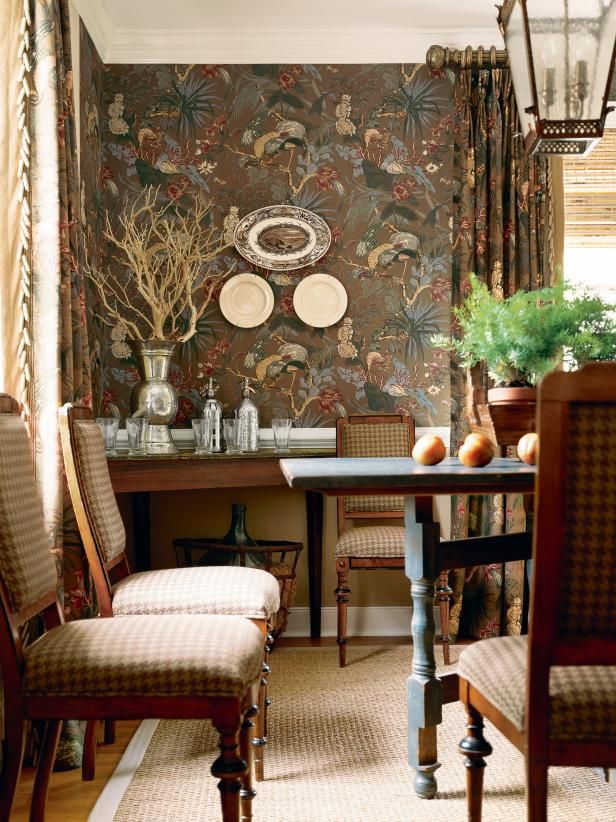
There is no need for shutters now. Instead, they use bamboo blinds, which cope with the task no worse than the old way.
In addition to windows, textiles are used for upholstery of armchairs and sofas, bedspreads and decorative pillows.
Tip! Pillows are a great way to add accents to a room. Place several products in the same style, and the room will noticeably change.
Designers recommend using natural fabrics for a colonial style home:
- silk;
- linen;
- fur;
- cotton;
- wool;
- velvet.
Several types of textiles can be combined in a room. For example, complement curtains made of the finest linen with chic velvet bedspreads. It will look richer and more interesting.
Please note! Don't overdo the decor. Everything should be in moderation.
Colonial style furniture
The beauty of this style is the variety of furniture elements.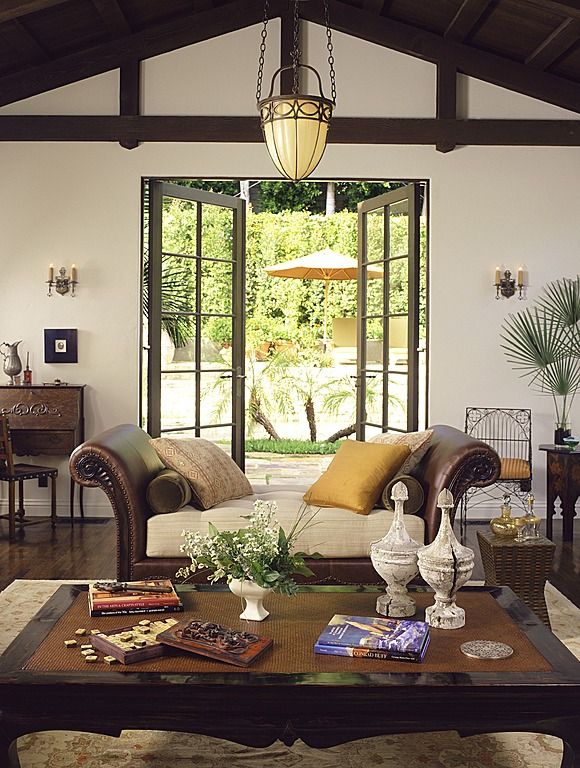 Among the many models of sofas and cabinets, you will definitely find your dream.
Among the many models of sofas and cabinets, you will definitely find your dream.
Here are some options for arrangement:
- Living room.
Who doesn't like to spend an evening on the sofa in the hall with family or friends? You can diversify the interior with the help of soft armchairs upholstered in pleasant fabric or leather, placed near an electric fireplace.
Carved wooden cabinets with books, soft ottomans, candles and a beautiful landscape above the fireplace will complement the decor. It is recommended to lay out several decorative pillows on the sofa and armchairs. Several pots with exotic plants, a warm carpet on the floor and a small dark wood coffee table - the atmosphere of such a living room will delight you every day.
2. Bedroom.
A huge four-poster bed, a ladies' table with a mirror in a gilded frame and a chest of drawers - these bedrooms seem to have come out of the screens of old films.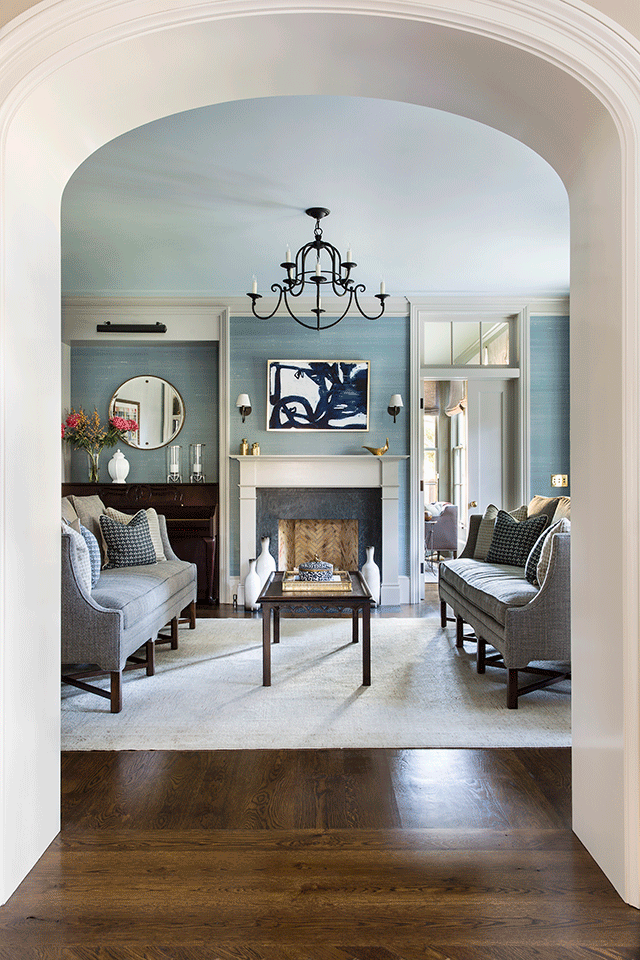 You will definitely feel cozy and comfortable in it.
You will definitely feel cozy and comfortable in it.
Use plants and decorative items to spice things up a bit. Do not overdo it with decor or furniture - the bedroom should have enough space and air.
An abundance of artificial light is not recommended in the room. Want more light? Large windows are ideal for a bright bedroom.
3. Kitchen.
Comfort and durability are the most important things in the kitchen. Solid wood furniture and countertops made of natural stone. A solid stone table is surrounded by dark wood chairs with soft velvet upholstery. This kitchen is the pride of the whole house.
You can also use your imagination and arrange the furniture the way you want – there are no strict restrictions.
Decor
What can be used as decoration besides plants and textiles? In this, you can show your imagination and realize your even the most daring decisions.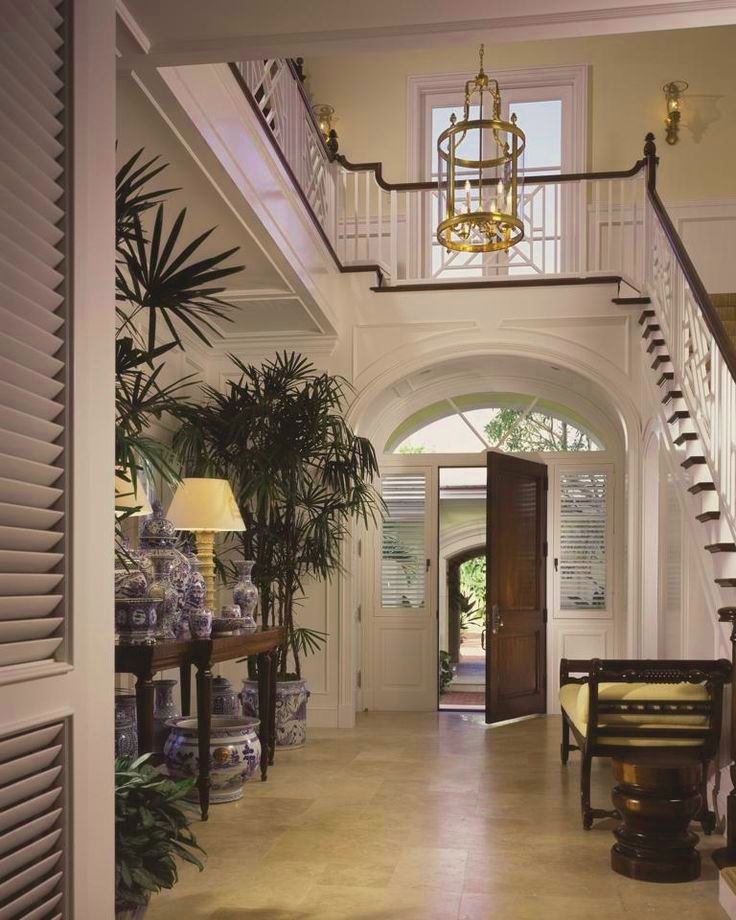
Designers recommend placing:
- Chinese style porcelain vases and screens;
- Savage masks;
- Animal skins;
- Pictures in solid wood frames;
- Antique mirrors;
- Books, chess, maps and globes.
A skillful combination of different decor elements will create a comfortable atmosphere in the house, which will always delight its owners.
Tip! Lamps made in the image of burning candles are an excellent replacement for ordinary light bulbs. Such a pleasure will cost a lot, but it will give amazing light and fit perfectly into the overall picture.
Be aware that overuse of decoration will make the room appear much smaller. If you do not want to clutter up the room, use a minimum of decorations.
Patterns
Colonial style - an amazing combination of restraint and exotic, civilization and wildlife. He was born exactly where animal skins, palm trees are an element of everyday life.